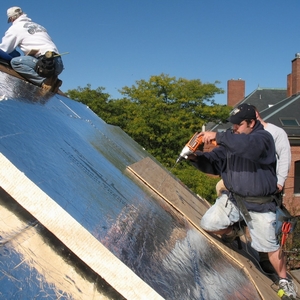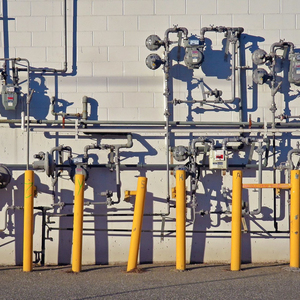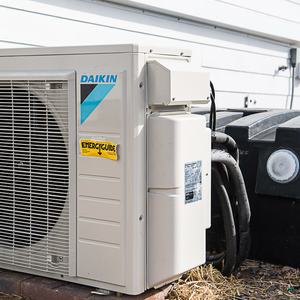
A new study of 93 million U.S. homes finds a big gap in greenhouse gas emissions between affluent and poorer households and says emissions goals in the Paris Agreement will be reached only if housing gets smaller, closer together, and more energy efficient.
The study, published on July 21 in the Proceedings of the National Academy of Sciences, is an attempt to learn how greenhouse gas emissions (GHG) across the country are affected by factors such as housing type, climate, affluence, and building attributes. The aim is to give state and local governments better information on which to base energy policy. The three authors—all affiliated with the School for Environment and Sustainability at the University of Michigan—said their research on the subject was the most comprehensive to date.
Residential energy use accounts for about 20% of U.S. greenhouse gas emissions, on a par with all emissions in Brazil and greater than those in Germany. By mid-century, there will be another 70 million to 129 million residents in the U.S. and as many as 105 million new houses. Houses are getting more energy efficient as time goes on, researchers said, but for a variety of reasons household energy use isn’t going down.
“This lack of progress undermines the substantial emission reductions needed to mitigate climate change,” the authors warned. “The average lifespan of an American home is about 40 years, which poses challenges given the need to rapidly decarbonize.”
Hitting the Paris Agreement target of a 28% reduction in GHG emissions by 2025 will be possible if the electric grid can be decarbonized. But that alone will not be enough to reach the 2050 reduction goal of 80% without significant changes in both housing and individual behavior.
The escalation of energy use, population and GHG emissions makes design and construction decisions for new housing crucial, the authors said, adding, “Without decisive action, there will be a ‘carbon lock-in’ for these homes for decades to come.”
Higher energy use in wealthy areas
Household energy use and emissions per square meter varies widely in different parts of the country. The demand for thermal energy and the type of fuel used to generate electricity were both key factors. Researchers said that meaningful reductions in GHG emissions will require grid decarbonization (the removal of fossil fuels from the generating mix), energy retrofits to existing houses and less energy use. It also will be important to build smaller houses and promote denser communities.
“Size matters in terms of carbon footprint,” lead author Benjamin Goldstein said in a telephone call. “If you’re in a bigger home, it doesn’t mean necessarily that you have to be emitting more carbon, but it seems to be more likely simply because you’re going to be using more energy to power, heat and cool that home.”
Unsurprisingly, states with mild climates have lower energy intensity (the amount of energy per square foot of floor area) while the north-central and northeastern states had much higher energy intensity. So, Maine, Vermont, and Wisconsin had the most energy intensity while Florida, Arizona, and California had the lowest.
Although there’s a connection between energy intensity and GHG intensity, that’s not always the case as researchers found in Vermont (high energy intensity but medium GHG intensity) and Missouri (medium energy intensity but very high GHG intensity). Researchers chalked that up to the carbon intensity of the utility grid; the advantages of low energy use can be canceled by high carbon intensity on the grid.
The study also found that because of the ongoing adoption of residential energy codes, newer housing typically uses less energy. But some of these gains are offset by design preferences, such as higher ceilings, that increase energy consumption.
Emissions by ZIP code
Wealthier people have carbon footprints that are on average 25% higher than low-income people, mostly due to the size of their houses. In very wealthy areas, these homes produce nearly 15 times more GHG than less affluent areas nearby, researchers found after looking at data from 8,858 separate ZIP codes.
“If we look at the people who live in those homes, that’s going to be more affluent Americans,” Goldstein said. “So there is certainly a climate justice aspect to this work, which is to say it raises questions about a collective conversation we need to have about who is emitting what and how we can address those emissions in a way that’s fair.”
Wealth and house size go up together, no matter what differences there might be in climate, the source of grid electricity, and building characteristics. In all parts of the country, increasing population density can be linked with smaller housing units and lower GHG emissions.
In particular, the authors took a close look at two major metropolitan areas—Boston-Cambridge-Quincy in Massachusetts and Los Angeles-Long Beach-Anaheim in California. One has a cold climate with mostly older buildings, the other a mild climate with newer housing stock.
“High-emission neighborhoods are primarily high income or extremely high income,” the study says. “In contrast, for both cities, 14 of the 20 neighborhoods with the lowest emissions fall below the poverty threshold.”
The researchers devised four scenarios that included different combinations of energy retrofits, cleaner grid electricity, and other strategies to see whether these two communities would be able to meet GHG reductions in the Paris Agreement. Boston, for example, would be able to meet the 2025 target if current trends of lower carbon intensity on the grid continue. But it would take a much more aggressive effort if the metro area were to meet the 2050 targets: heat pumps in 30% of all homes and distributed, low-carbon energy sources for 40% of homes.
“The United States is unlikely to meet the 2050 goal, even with aggressive home retrofits and grid decarbonization, due to continued in-home fossil fuel use,” the study predicts. It would take a variety of steps to lower emissions on both the production and consumption sides in order to hit GHG targets.
Among them:
- A 86% reduction in coal use and a 60% increase in renewables on the grid.
- Deep energy retrofits to reduce heating, cooling, and lighting loads.
- On-site solar electricity or solar hot water in one-third of all homes, along with on-site energy storage.
- Building smaller houses with zoning for more densely populated communities.
“All these measures need to happen in concert,” the report says. “Although ambitious, the form of the current U.S. housing stock is not only the outcome of consumer preferences, but also policies enacted since the 1950s…Given this history, it is conceivable that a concentrated effort could enable the U.S. residential sector to meet Paris Agreement targets.”
We don’t need a ‘silver bullet’
Goldstein said tools to lower carbon emissions are already available. “We have the technology to do it,” he said. “We don’t need any silver bullet. We don’t have to come up with cold fusion to get there. But we do need political will, and we do need some changes to individual and perhaps housing choices.”
Achieving the Paris Agreement emissions target will be possible even with continued fossil fuel use, he said. Researchers estimated, for example, that 30% of homes could be burning natural gas in 2050 and still hit the target. And while suburban sprawl doesn’t help, not everyone will have to live in a Manhattan-like environment. “It’s not one or zero,” he said, “it’s not binary. But we do need to move the needle significantly.”
Building smaller houses that are “equally as habitable but not necessarily as spacious” as some of today’s single-family homes would be a big help, as would choosing low-carbon means of heating and cooling—heat pumps over natural gas furnaces.
“How can we think of alternative ways to live is really a bigger question that this work brings to mind,” Goldstein said. “How can we live in a low-carbon way? Once again it comes to this collective discussion we need to have about what matters and how can we move toward a low carbon society in an equitable manner.
“I think there is the will there,” he continued. “I think that as the consequences of climate change are becoming more and more felt, a lived reality as opposed to an abstract concept, there will be push for system change, and it will be harder to ignore. I don’t know if we’ve reached that tipping point yet. We’ll reach it soon enough.”
Scott Gibson is a contributing writer at Green Building Advisor and Fine Homebuilding magazine.
Weekly Newsletter
Get building science and energy efficiency advice, plus special offers, in your inbox.















3 Comments
“The average lifespan of an American home is about 40 years...” I think the authors mean that the average age of an American home is about 40 years. Given the proportion of housing stock that was built well before 1980, for the average lifespan of a house to be 40 years, many houses would have to be torn down at well under 40 years old, which does not seem especially likely. That said, increasing the average lifespan of a house seems like a good goal as well.
"mostly due to the size of their houses"
took the words right out of my mouth
This is a great article that I must have overlooked this summer. We knew how to build highly efficient and very comfortable, livable homes 35 or 40 years ago. What happened? Corporatism. Some of us had the Utopian view those many years ago that energy efficiency was a good thing and it is. I sat in on energy code task force meetings in the early 2000's here (MN) and the opposition to energy code improvements by the production builders was fierce. The MN Department of Commerce did a great job in moving our energy code forward in the late 1990's and early 2000's and we are much better for it. Little progress has been made since then as we are being held back by the entrenched powers that be in the home building industry.
Log in or create an account to post a comment.
Sign up Log in